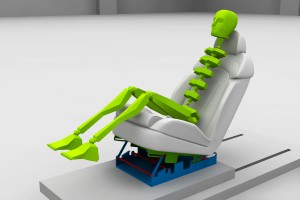The Impact Reducer has safety in mind
Posted: 29 March 2011 | | No comments yet
High-speed train travel has become the travel of choice during recent decades and passenger numbers have increased drastically…
High-speed train travel has become the travel of choice during recent decades and passenger numbers have increased drastically...
High-speed train travel has become the travel of choice during recent decades and passenger numbers have increased drastically.


The design of the Impact Reducer changes the attitude of the seat to an attitude in which it is tilted backwards so as to shift the trajectory of the inertial force which acts through the centre of gravity of the person to be directed through the seat rather than away from the backrest
Although passenger safety was long neglected it has since become of utmost importance. Recently, crumple zones (long used in cars) have been introduced in passenger coaches to absorb the energy more gradually in the event of a front-end collision with the intention of reducing the harm inflicted to passengers. However, this measure can only introduce an improvement of limited degree and passengers still travel forward at the original travelling speed while the coach comes to what is still a sufficiently abrupt halt to cause injuries. Passengers are therefore thrown forward – resulting in serious injuries or even death. Seat belts are not provided in the case of trains apparently because the custom became established of seeing trains as more relaxed environments in which people can move about freely.
This inspired the design of the Impact Reducer, an invention that lies in the field of impact reduction, applied to reducing the effect of impacts on individuals. The design of the Impact Reducer in its first stage changes the attitude of the seat in which it is normally horizontal or close to horizontal to an attitude in which it is tilted backwards so as to shift the trajectory of the inertial force which acts through the centre of gravity of the person to be directed through the seat rather than away from the backrest. This is crucial to ensure that the person remains within the seat and reduces the tendency for a person to slide off the seat. During the second stage it decelerates relatively gradually in response to the impact and the design thus both reduces the effect of the seatbelt on the passenger when it decelerates upon an impact occurring and instead tends to settle the person more securely in the seat.
The second key aspect of the invention, the energy absorber, is designed to absorb energy as the seat moves forward, so as to bring the seat to a halt progressively over the distance that the seat moves forward upon an impact occurring. This reduces the forces acting on the body of the person as compared to a sudden or near instantaneous stop where the forces can become enormously great, so as to avoid serious injury or death. The energy to be absorbed will vary according to the combined mass of the seat and the passenger, the latter obviously varying according to the passenger. The energy to be absorbed will also vary according to the speed of the train concerned at the moment of impact. The rate of energy absorption with displacement of the seat must be proportional to the product of the speed and the total mass of seat and passenger, that is, the momentum of seat and passenger. Since the mass of the seat is a constant the range of masses resulting from persons of different mass that must be catered for is reduced. The product of speed and mass is the momentum of the seat and passenger and this must be absorbed by the energy absorber by the work done over the distance that the seat moves after impact, being the product or integral of the resistance over this distance. Energy absorption can typically be provided by dry frictional effects or viscosity effects, the latter for example in hydraulic dampers or ‘shock absorbers’ as used in suspension systems, duly modified for this purpose by purpose designed viscous dampers. Both frictional, pneumatic and viscous effects can be applied in the mechanism.
The range of possibilities that must be catered for is wide. For optimum protection, the shock absorber should preferably be adjustable and controlled by computer. By combining computer control with the Impact Reducer the possibilities and combinations become endless. The adjustment must be automatic by weighing the person and measuring the speed at any given instant. The computer then uses the measures of weight and speed to adjust the energy absorption rate. Magneto – Rheological shock absorbers should be the best suited, but there may be other practical means.
The Impact Reducer will be kept in a static position by electromagnets. In the event of an accident, the computer will release the magnets that will activate the Impact Reducer to ensure that maximum protection would be provided on the moment of impact.
The product is characterised by mechanical simplicity and reliability with the added benefit of low cost. It was designed with confined spaces in mind and is thus very compact. Moving from the static position to the fully activated position should not consume more than 150mm. The fact that the computer takes the combined weight of the seat and the passenger, even if there is no passenger in the seat, into account when adjusting the shock absorber means that all the seats would move the same distance and at the same tempo. This will ensure that the distance between the rows will remain constant.
Watch the video:
PCT Application nr .PCT/ZA 2009/000050
Proprietor Charles Taylor Phillips
Contact details:
Mobile: 2783 449 9918
Office: 2718 462 7646
Fax: 2718 462 8122
Email: [email protected]
Global Railway Review Autumn/ Winter Issue 2025
Welcome to 2025’s Autumn/ Winter issue of Global Railway Review!
The dynamism of our sector has never been more apparent, driven by technological leaps, evolving societal demands, and an urgent global imperative for sustainable solutions.
>>> Read the issue in full now! <<<







